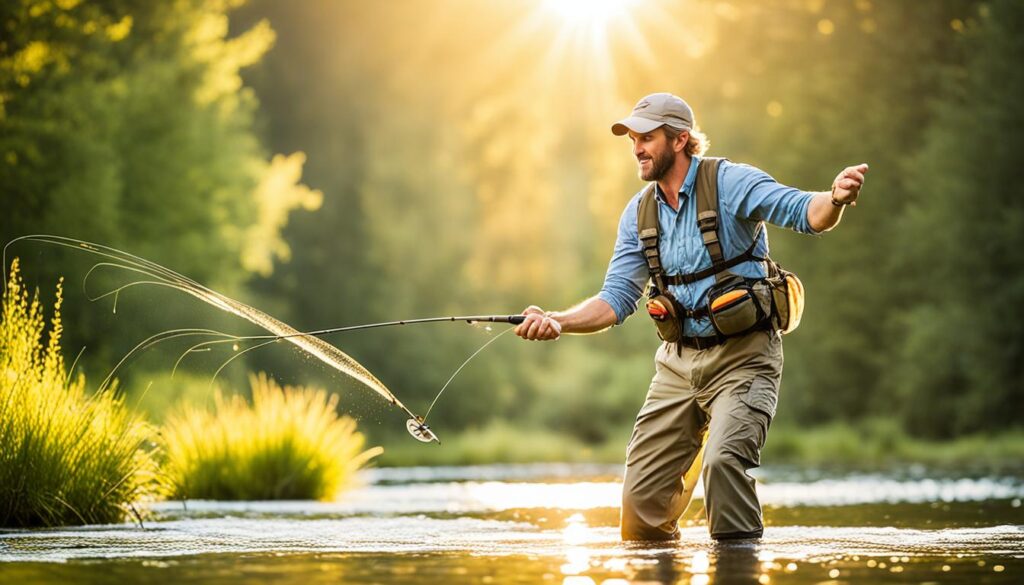Fly fishing is a captivating pursuit that combines the art of casting with the thrill of catching fish. In this beginner’s guide, we’ll explore the basics of fly fishing, essential gear, casting techniques, choosing fishing spots, understanding fly patterns and presentation, and the importance of practice and patience. By the end of this guide, you’ll be equipped with the knowledge and skills to embark on your own fly fishing journey.
Key Takeaways:
- Fly fishing is an art that combines casting with the excitement of catching fish.
- Understanding the basics of fly fishing is crucial for beginners.
- Essential gear includes a fly rod, reel, line, leaders, tippet, and flies.
- Mastering casting techniques is essential for success in fly fishing.
- Choosing the right fishing spot increases your chances of catching fish.
Embark on the exciting journey of fly fishing and immerse yourself in the beauty of nature and the art of angling. This beginner’s guide will provide you with step-by-step instructions and essential tips to get you started on your fly fishing adventure. Learn the basics, gather the necessary gear, perfect your casting technique, and discover the best fishing spots for a fruitful experience. Remember, practice and patience are key to mastering the art of fly fishing. So, let’s dive in and explore the world of fly fishing together!
Fly fishing is a method of catching fish using an artificial fly as bait. The key difference between fly fishing and traditional bait or lure fishing is how you cast the line. In fly fishing, you use a specialized fly rod, reel, and line to cast the fly and deliver it gently to the water’s surface, mimicking the natural movements of insects or small prey fish. This section will cover the fundamental principles of fly fishing and introduce you to the unique aspects of this art form.
If you’re new to fly fishing, understanding the basics is essential for a successful and enjoyable experience. Whether you’re casting the line for the first time or looking to enhance your skills, these beginner fly fishing tips will help you get started:
1. Choose the Right Fly Fishing Gear
Before you hit the water, make sure you have the essential fly fishing gear. Invest in a fly rod, reel, and line suitable for beginners. Consider the type of fish you’ll be targeting and the fishing conditions you’ll encounter. Research and seek guidance from experienced anglers or fly fishing professionals to ensure you have the right gear for your specific needs.
2. Learn the Basic Casting Techniques
Mastering proper casting techniques is crucial for successful fly fishing. Practice your casting motion, including the backcast and forward cast, to achieve accuracy and distance. Focus on smooth, controlled movements and aim to present your fly gently on the water’s surface. Experiment with different casting angles and techniques to adapt to varied fishing scenarios.
3. Understand Fly Selection and Presentation
The choice of fly and its presentation are vital in attracting fish. Familiarize yourself with local fly patterns and the insects or prey fish they imitate. Study fish behavior and feeding habits to determine the best fly to use. Pay attention to details like fly size, color, and the manner in which it moves on the water. Practice presenting the fly in a lifelike manner to entice fish into biting.
4. Explore Different Fishing Spots
When starting your fly fishing journey, it’s essential to explore various fishing spots to find the ones that suit your preferences and fishing aspirations. Research potential locations, consider factors such as accessibility and local fishing regulations, and learn about the fish species that inhabit each spot. Experiment with both stillwater and moving water environments to gain diverse fishing experiences.
5. Practice Patience and Observation
Fly fishing is not just about casting and catching fish—it’s also about immersing yourself in nature and observing its intricacies. Practice patience and take the time to study fish behavior, insect hatches, and the overall ecosystem. Pay attention to subtle cues and make adjustments to your fishing strategy accordingly. The more you observe and learn, the more you’ll evolve as a fly angler.
Remember, fly fishing is a skill that develops over time. Be patient with yourself as you progress through the learning curve. With dedication, practice, and a spirit of exploration, you’ll soon find yourself captivated by the beauty and excitement that fly fishing has to offer.
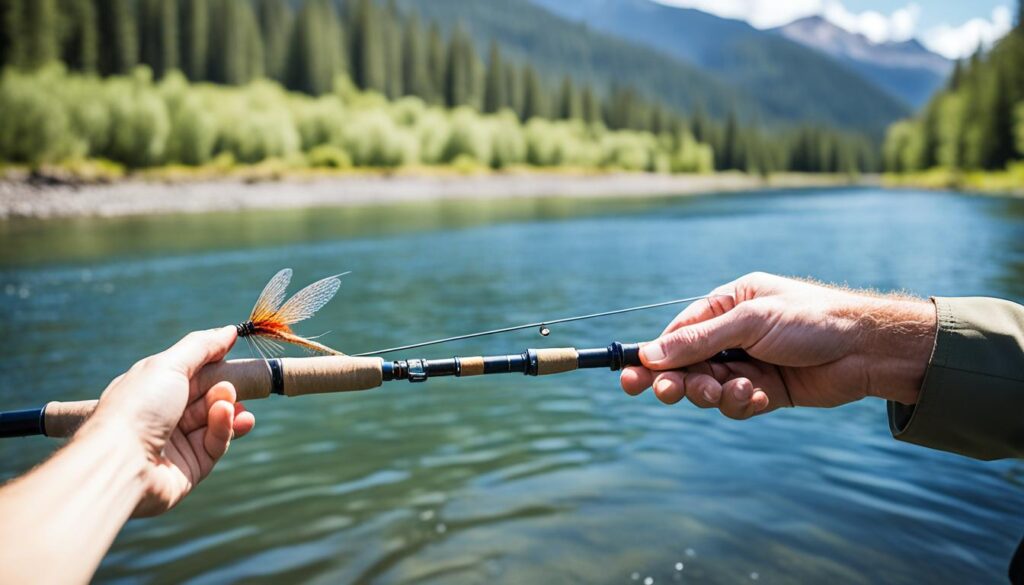
Essential Fly Fishing Gear
Before you can start fly fishing, it’s important to gather the right equipment. Here, I’ll outline the essential fly fishing gear you’ll need to ensure a successful and enjoyable fishing experience. By investing in quality gear, you’ll be well-prepared for your fly fishing adventures.
Fly Fishing Gear Checklist
Here is a comprehensive checklist of the essential fly fishing gear you’ll need:
| Item | Description |
|---|---|
| Fly rod | A lightweight rod designed specifically for fly fishing. It’s essential for accurate casting and line control. |
| Reel | A reel that holds the fly line and provides drag to control the fish. |
| Fly line | A specialized line designed for fly fishing, available in different weights to match your rod and fishing conditions. |
| Leaders | Transparent monofilament or fluorocarbon lines that connect the fly line to the fly. |
| Tippet | Additional transparent line that extends the leader and provides strength and stealth to the setup. |
| Flies | Artificial imitations of insects, small fish, or other prey that attract fish. Flies come in a variety of patterns and sizes to match different fishing situations. |
Remember, it’s important to choose gear that suits your skill level and fishing conditions. Now, let’s take a closer look at each piece of essential gear and its significance in fly fishing.
Fly Rod
The fly rod is the heart of your fishing setup. It allows you to cast the fly and control the line. When selecting a fly rod, consider the following factors:
- Length and weight: Choose a rod length and weight that suits the fishing environment and target species. Longer rods provide greater casting distance, while shorter rods offer better accuracy.
- Action: Fly rods have different actions, ranging from slow to fast. Beginners generally benefit from medium to medium-fast action rods that are forgiving and easy to cast.
- Material: Fly rods can be made of various materials, such as graphite, fiberglass, or bamboo. Graphite rods are popular among anglers for their strength, sensitivity, and versatility.
Reel
The fly reel is responsible for holding the fly line and providing drag when battling fish. Consider the following aspects when choosing a reel:
- Drag system: A good drag system ensures a smooth and controlled line release when a fish pulls. Look for reels with an adjustable drag mechanism.
- Size and weight: Match the reel size and weight to your fly rod to maintain proper balance in your setup.
- Construction: Reels are typically made of aluminum, graphite, or a combination of both. Aluminum reels offer durability, while graphite reels are lightweight and corrosion-resistant.
Fly Line
Choosing the right fly line is crucial for casting and presenting your fly effectively. Consider the following factors when selecting fly line:
- Weight: Fly lines are categorized by weight, which corresponds to the weight of the fly rod. Matching the line weight to your rod ensures optimal casting performance.
- Taper: Fly lines have different tapers, including weight-forward, double taper, and level taper. Weight-forward lines are versatile and suitable for most fishing situations.
- Sinking or floating: Fly lines can be sinking or floating. Floating lines are the most common and versatile choice for various fishing environments.
Leaders and Tippet
Leaders and tippet complete the connection between your fly line and fly. They play a crucial role in presenting the fly naturally and fooling the fish. Consider the following when selecting leaders and tippet:
- Length and strength: Leaders and tippet come in different lengths and breaking strengths. Choose a length and strength suitable for your fishing conditions and target species.
- Material: Leaders and tippet are usually made of monofilament or fluorocarbon. Monofilament is more affordable, while fluorocarbon offers greater invisibility in the water.
Flies
Flies imitate the natural prey that fish feed on. They come in various patterns and sizes, each designed to mimic specific insects, baitfish, or other aquatic creatures. When selecting flies, consider the following:
- Local insect hatches: Research the insect hatches in the area you plan to fish. Matching the hatch increases your chances of success.
- Fly patterns: Different fly patterns have different characteristics and actions in the water. Experiment with a variety of patterns to see what works best.
- Sizes: Flies come in various sizes to match the size of the insects or prey fish in the water. Pay attention to the size of the food source your target fish are likely to feed on.
With this overview of the essential fly fishing gear, you’re now equipped with the knowledge to make informed purchasing decisions. Remember to choose gear that suits your skill level, fishing conditions, and target species. In the next section, we’ll explore the art of casting techniques to help you effectively cast your fly and present it to the fish.
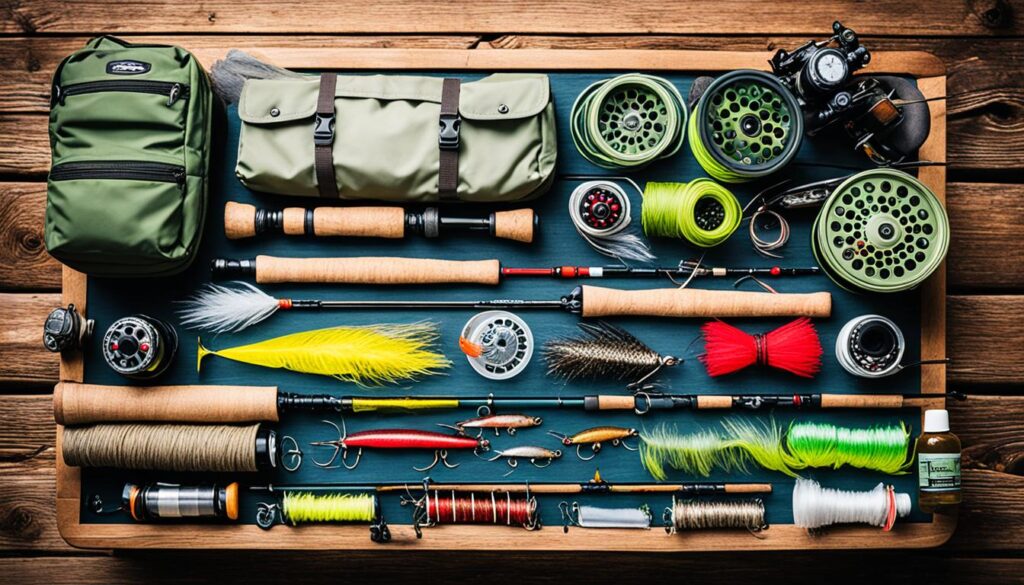
Casting Techniques
Mastering the art of casting is essential for successful fly fishing. In this section, I will guide you through the fundamental steps of casting a fly rod. By understanding proper technique and incorporating some helpful tips, you’ll be well on your way to making accurate and precise casts.
Gripping the Rod: Before you begin casting, it’s important to have a proper grip on the rod. Hold the rod with a relaxed grip, placing your thumb on top of the handle and your index finger extending along the rod’s underside. This grip allows for better control and flexibility during the casting motion.
Managing the Line: To effectively cast, you’ll need to manage the line by keeping it free from tangles and ensuring it flows smoothly through the rod’s guides. Before each cast, release enough line from the reel and hold it loosely in your non-dominant hand, commonly known as the line hand.
Performing a Backcast and Forward Cast: The casting motion consists of two main components: the backcast and the forward cast. These movements create the necessary loop in the line to propel the fly towards the target. To execute a backcast, smoothly lift the rod tip behind you, allowing the line to straighten out fully. Next, initiate the forward cast by driving the rod tip forward, using a flicking motion of your wrist. This transfers energy to the line and propels the fly towards the desired location.
Mending the Line: As you gain more experience with casting, you’ll encounter situations where you need to mend the line to achieve a drag-free drift. Mending involves repositioning the line after the cast to counteract current and ensure the fly moves naturally in the water. To mend the line, use a roll or reach cast to reposition the line upstream or downstream, allowing for a more controlled presentation.
Remember, practice and patience are vital to improving your casting technique. The more you practice, the better your casting will become. Don’t be discouraged if it takes time to perfect your casts. With persistence, you’ll develop the skills to make accurate and precise casts that effectively present your fly to the fish.
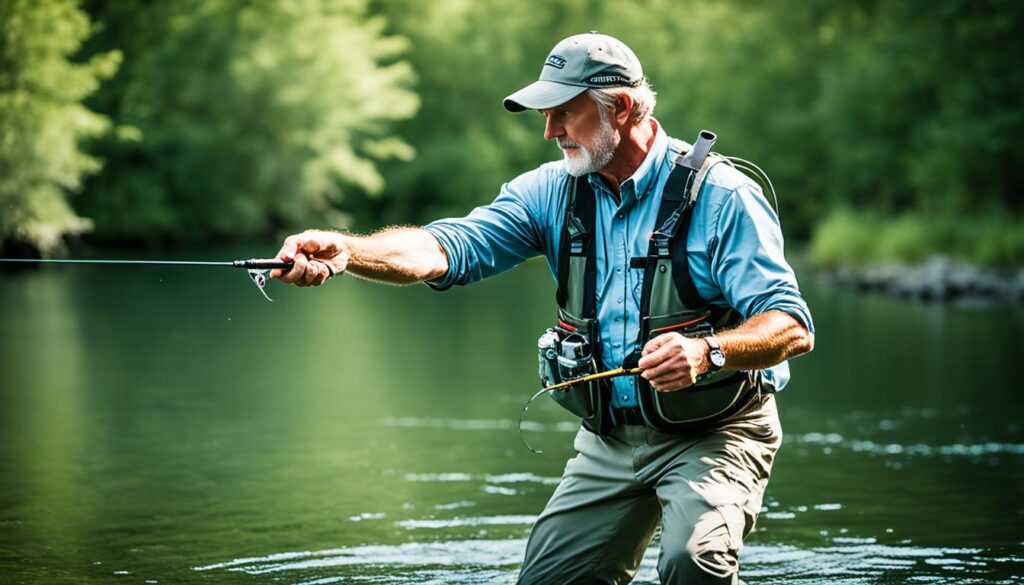
Remember, practice and patience are vital to improving your casting technique.
Choosing Your Fishing Spot
Fly fishing offers anglers a wide range of fishing spots to explore, from peaceful rivers to serene lakes and scenic ponds. The key to a successful fly fishing experience lies in selecting the right fishing spot. To help you make an informed decision, here are some valuable tips to consider:
Research Fish Species and Their Preferred Habitats
Before you embark on your fly fishing adventure, take the time to research the fish species that inhabit the waters you plan to fish in. Each species has its own preferred habitats and behavior patterns. By understanding these characteristics, you can significantly increase your chances of finding and catching fish. Researching local fishing reports, online resources, and guidebooks will provide valuable insights into the best locations to target your desired fish species.
Observe Signs of Fish Activity
Learning to read the water and recognize signs of fish activity is essential for identifying productive fishing spots. Look for rising fish, water disturbances, swirls, and feeding activity on the surface. These indicators can help you locate areas where fish are actively feeding and increase your chances of a successful catch.
Ensure Legal Access to the Water
Before casting your line, ensure that you have legal access to the water in the chosen fishing spot. Research fishing regulations and obtain any necessary permits or licenses. Respecting fishing laws not only ensures compliance but also helps preserve the natural environment and the sport for future generations.
Prioritize Safety
When selecting a fishing spot, prioritize safety. Consider factors such as water depth, currents, and potential hazards. It’s important to choose spots that are suitable for your skill level and experience. Always wear appropriate safety gear, including a personal flotation device, and inform someone of your fishing plans.
By following these tips, you’ll be well-equipped to choose the perfect fishing spot for your next fly fishing adventure. Remember, the right spot can make all the difference in your fishing success and overall enjoyment of the sport!
Understanding Fly Patterns and Presentation
To effectively catch fish in fly fishing, it’s crucial to understand the insects and aquatic life that fish feed on. By studying fly patterns and perfecting your presentation, you’ll increase your chances of enticing fish to bite.
Researching Local Hatch Charts
One of the first steps in understanding fly patterns is to research local hatch charts. These charts provide valuable information on the types of insects that hatch in specific bodies of water at different times of the year. By knowing which insects are present, you can select fly patterns that closely mimic them and increase your chances of attracting fish.
Observing Natural Prey
To further enhance your understanding of fly patterns, spend time observing the natural prey that fish feed on. Take note of the size, shape, and color of insects in and around the water. This firsthand observation will help you choose flies that closely resemble the natural food sources, making your presentation more convincing to the fish.
Selecting the Right Fly Patterns
With knowledge of local hatch charts and observations of natural prey, you can select the right fly patterns for your fishing session. Choose flies that match the size, shape, and color of the insects prevalent in the water. It’s also beneficial to have a variety of fly patterns to cover different fishing conditions and mimic various stages of insect life cycles.
Presenting Flies Convincingly
The way you present your fly can greatly impact your fishing success. When casting, aim for a gentle landing that mimics the natural movement of insects or small prey fish. Avoid splashing or creating disturbances in the water that might alarm the fish. Pay attention to the speed and depth of your retrieve, mimicking the behavior of the target prey. By presenting your fly convincingly, you’ll increase the likelihood of triggering a strike.
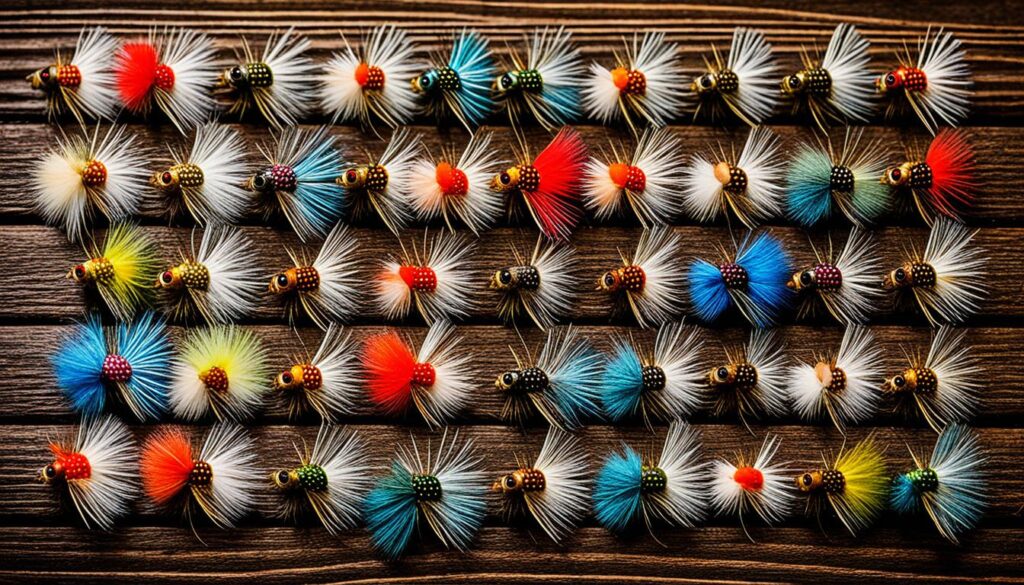
Mastering fly patterns and presentation is a continuous learning process in fly fishing. By fine-tuning your fly selection and perfecting your presentation techniques, you’ll become more proficient at enticing fish to bite. Enjoy the art of fly fishing and embrace the journey of mastering this timeless sport.
Practice and Patience
Fly fishing is not a skill that can be mastered overnight. It requires dedication, practice, and patience. As a beginner, it’s essential to understand that fly fishing is an art form that takes time to develop. Embracing the process of learning and improving is paramount to becoming a proficient angler.
To enhance your fly fishing skills, here are some beginner tips that emphasize the importance of practice and patience:
- 1. Practice Casting: One of the core skills in fly fishing is casting. Spend time honing your casting technique by practicing in open spaces such as backyards or local parks. Focus on mastering the basics of both the backcast and forward cast, and gradually work on accuracy and distance.
- 2. Study Fish Behavior: Understanding the behavior of fish and aquatic life is essential in fly fishing. Take time to observe fish in their natural habitat, whether by a river or a clear lake. Pay attention to their feeding patterns, movement, and preferred habitats. The more you learn about the fish, the better you can tailor your approach.
- 3. Learn from Each Fishing Experience: Every fishing trip is a valuable learning opportunity. Reflect on your fishing experiences, both successes and failures, and take note of what worked and what didn’t. This self-reflection will help you understand the nuances of fly fishing and fine-tune your techniques.
“Fly fishing is an art that rewards those with persistence and a willingness to learn.” – Unknown
Remember, progress in fly fishing is a journey. It’s normal to experience challenges along the way, but with consistent practice and a patient mindset, you’ll develop the skills necessary to become a proficient angler.
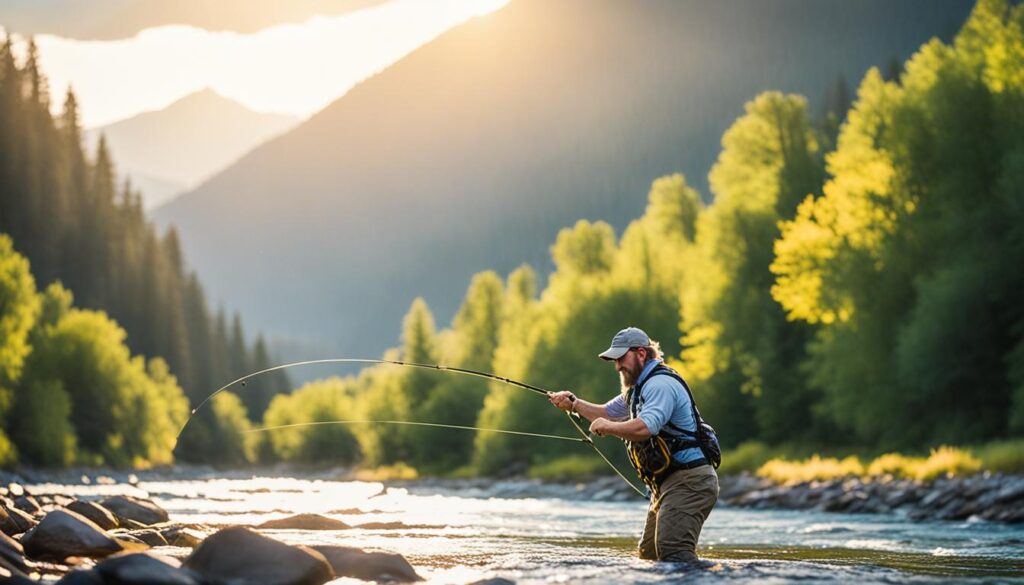
| Benefits of Practice and Patience | How to Cultivate Patience |
|---|---|
| 1. Improved casting accuracy | 1. Set realistic goals |
| 2. Better understanding of fish behavior | 2. Embrace the learning process |
| 3. Increased adaptability on the water | 3. Take breaks and enjoy the surroundings |
| 4. Enhanced problem-solving skills | 4. Patience with yourself and the fish |
| 5. Greater appreciation for the sport | 5. Practice mindfulness while fishing |
By nurturing your practice routine and embracing patience, you’ll unlock the true potential of fly fishing and cultivate a lifelong passion for this captivating sport.
Gear Up For Success
When it comes to fly fishing, having the right gear can make all the difference in your experience on the water. In this section, I’ll introduce you to beginner-friendly fly fishing gear options that will set you up for success.
Combo Kits for Easy Start
If you’re just getting started with fly fishing, a combo kit is a great option. These kits include everything you need to hit the water and start fishing. They typically come with a fly rod, reel, line, and sometimes even leaders and flies. Combo kits are designed specifically for beginners, making it easy to get started without the hassle of selecting individual gear pieces.
One highly recommended combo kit for beginners is the Orvis Clearwater Fly Rod Outfit. This kit includes a high-quality rod, reel, and line that are well-suited for beginners. It’s a great value for the price and provides a solid foundation for learning the art of fly fishing.
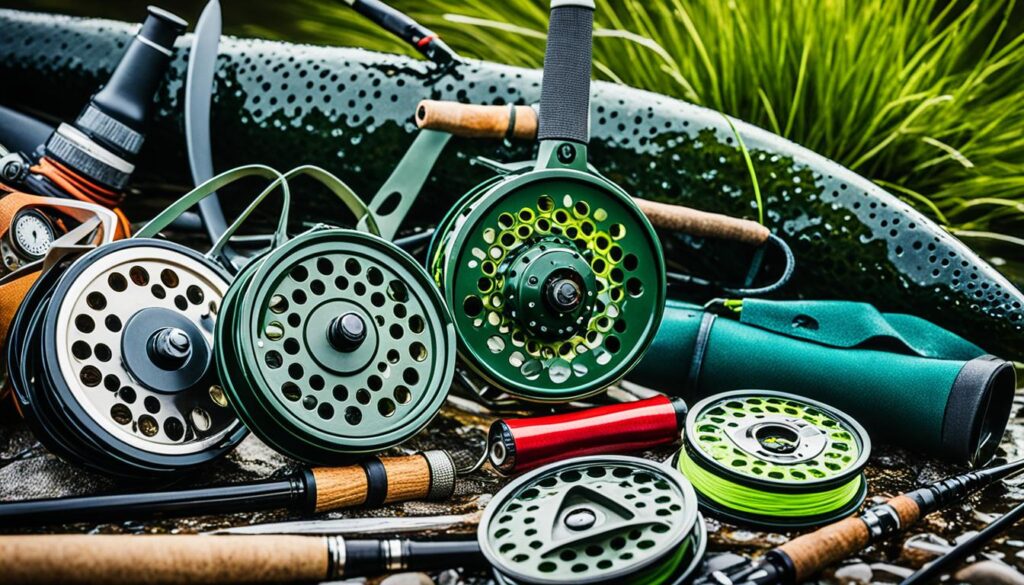
Custom Setups for Personalization
For those who want more customization and higher performance, building a custom setup is the way to go. With a custom setup, you have the freedom to choose each component of your gear based on your specific needs and preferences.
When building a custom setup, it’s important to consider factors such as the type of fish you’re targeting, the fishing environment, and your casting style. Custom setups allow for greater versatility and can be tailored to your individual fishing style, giving you a more personalized and optimized experience on the water.
A highly recommended fly rod for custom setups is the Sage Foundation Fly Rod. It offers excellent performance and versatility, allowing you to easily adapt to different fishing situations. Pair the rod with a high-quality reel, such as the Lamson Liquid Fly Reel, and a suitable line, and you’ll have a custom setup that delivers precision and control.
Choosing the Right Gear for Success
Whether you opt for a combo kit or a custom setup, choosing the right gear is essential for a successful fly fishing journey. Here are a few key tips to keep in mind:
- Consider the type of fish you’ll be targeting and select gear specifically designed for that species.
- Research the fishing environment to determine the appropriate rod weight and length.
- Invest in a high-quality reel with a smooth drag system for better control over your line.
- Choose the right line weight and type based on the fishing conditions and your casting ability.
- Don’t forget about leaders and tippet, which are crucial for presenting your fly effectively.
By equipping yourself with the right gear, whether it’s a beginner-friendly combo kit or a personalized custom setup, you’ll be well-prepared for the challenges and excitement of fly fishing. Gear up for success and embark on a journey that will ignite your passion for this timeless sport.
Fly Fishing Etiquette
Fly fishing is not only about catching fish but also about respecting nature and fellow anglers. As anglers, it is our responsibility to follow certain etiquette guidelines to ensure the longevity and enjoyment of the sport. By practicing good etiquette, we can foster a positive environment on the water and maintain the beauty of the natural surroundings that make fly fishing so special.
The Principles of Fly Fishing Etiquette
Respecting nature and fellow anglers is at the core of fly fishing etiquette. Here are some essential principles to keep in mind:
- Catch and Release: When fly fishing, it’s important to practice catch and release whenever possible. This helps maintain healthy fish populations and ensures future generations can enjoy the sport.
- Respect Other Anglers’ Space: Give fellow anglers plenty of space and avoid encroaching on their fishing spots. Be mindful of their lines and avoid crossing or tangling them. A respectful distance allows everyone to focus on their fishing experience.
- Adhere to Local Fishing Regulations: Familiarize yourself with the fishing regulations of the area you are fishing in. Observe any size limits, fishing seasons, and special restrictions to protect the fishery and abide by the law.
By following these principles, you can contribute to the preservation of fly fishing and ensure a harmonious experience for all anglers.
Fly Fishing Etiquette Guidelines
| Guidelines | Explanation |
|---|---|
| Catch and Release | Release fish unharmed whenever possible to support sustainable fisheries. |
| Respect Other Anglers’ Space | Give fellow anglers enough room to fish comfortably and avoid interfering with their lines. |
| Observe Local Fishing Regulations | Understand and follow the fishing regulations specific to the area you are fishing in to protect the fishery and comply with the law. |
| Dispose of Waste Properly | Pack out all your trash, including used fishing line, to keep the fishing environment clean and free from litter. |
| Respect Wildlife | Observe and appreciate wildlife from a distance, avoiding any disruption to their natural behavior. |
| Leave No Trace | Minimize your impact on the environment by leaving the area as you found it, without leaving any trace of your presence. |
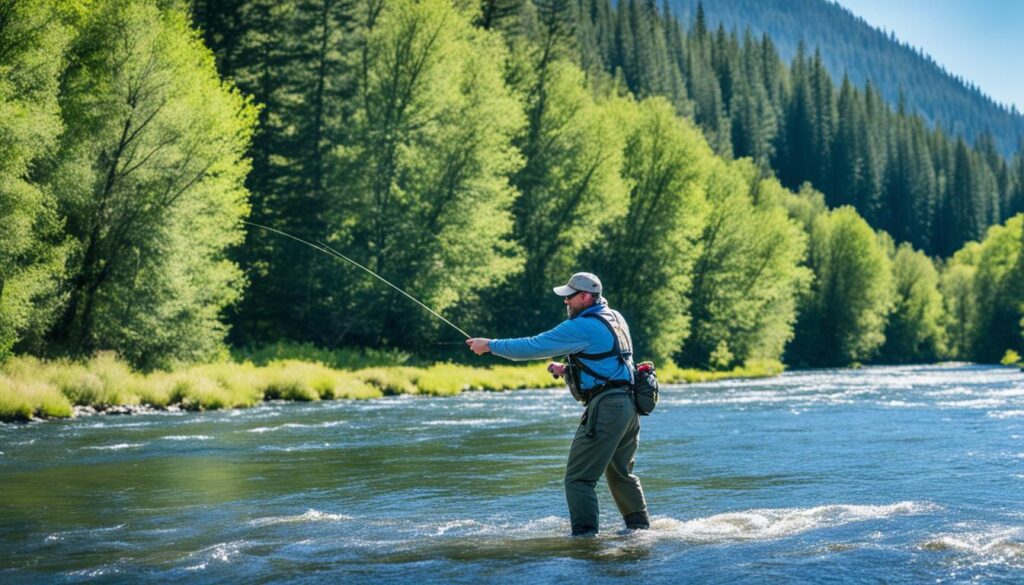
By adhering to these fly fishing etiquette guidelines, you can contribute to a positive fishing experience for yourself, fellow anglers, and the natural environment. Let’s respect nature and each other, ensuring that fly fishing remains a cherished activity for generations to come.
Conclusion
Fly fishing is more than just a sport; it is a lifelong passion that connects us with nature and provides a sense of fulfillment like no other. As a beginner, learning the basics of fly fishing and honing your skills through practice and patience is essential. By embracing the journey of fly fishing, you’ll embark on an adventure filled with excitement, tranquility, and personal growth.
Throughout this guide, we have covered everything from the fundamentals of fly fishing to choosing the right gear, casting techniques, and understanding fly patterns. By applying these beginner fly fishing tips, you’ll be well on your way to becoming a master angler.
But remember, fly fishing is not just about catching fish. It’s about immersing yourself in nature, respecting the environment, and cherishing the moments spent by the water. As you continue your fly fishing journey, you’ll constantly learn and improve, discovering new techniques, exploring different fishing spots, and embracing the beauty of the outdoors.
So grab your fly rod, tie on that perfect fly, and let the rhythm of the water guide you. Embrace fly fishing as a lifelong passion and create memories that will last a lifetime. Whether you’re casting on a pristine river or a quiet pond, fly fishing mastery awaits you, and with it, a world of endless joy and wonder.
FAQ
What is fly fishing?
Fly fishing is a method of catching fish using an artificial fly as bait. It involves using a specialized fly rod, reel, and line to cast the fly and mimic the natural movements of insects or small prey fish.
What gear do I need to start fly fishing?
Essential gear for fly fishing includes a fly rod, reel, line, leaders, tippet, and flies. Each piece of gear serves a specific purpose in the fly fishing process.
How do I cast a fly rod?
Casting a fly rod involves gripping the rod, managing the line, performing a backcast and forward cast, and mending the line. Practice and technique are important for improving your casting skills.
How do I choose the right fishing spot for fly fishing?
To choose the right fishing spot, research fish species and their preferred habitats, observe signs of fish activity, ensure legal access to the water, and prioritize safety.
How do I understand fly patterns and present them convincingly?
Research local hatch charts, observe natural prey, select the right fly patterns, and present them convincingly to the fish. Study and practice are key to improving your fly pattern knowledge and presentation skills.
How important is practice and patience in fly fishing?
Practice and patience are crucial in developing your fly fishing skills. By practicing casting, studying fish behavior, and learning from each fishing experience, you can improve and enjoy the sport even more.
What gear options are available for beginners?
Beginner-friendly gear options include combo kits and custom setups. Combo kits offer a complete package with all the necessary gear, while custom setups allow for more personalized gear selection.
What is the etiquette for fly fishing?
Fly fishing etiquette includes practices such as catch and release, respecting other anglers’ space, and adhering to local fishing regulations. It’s important to respect nature and fellow anglers while enjoying the sport.
